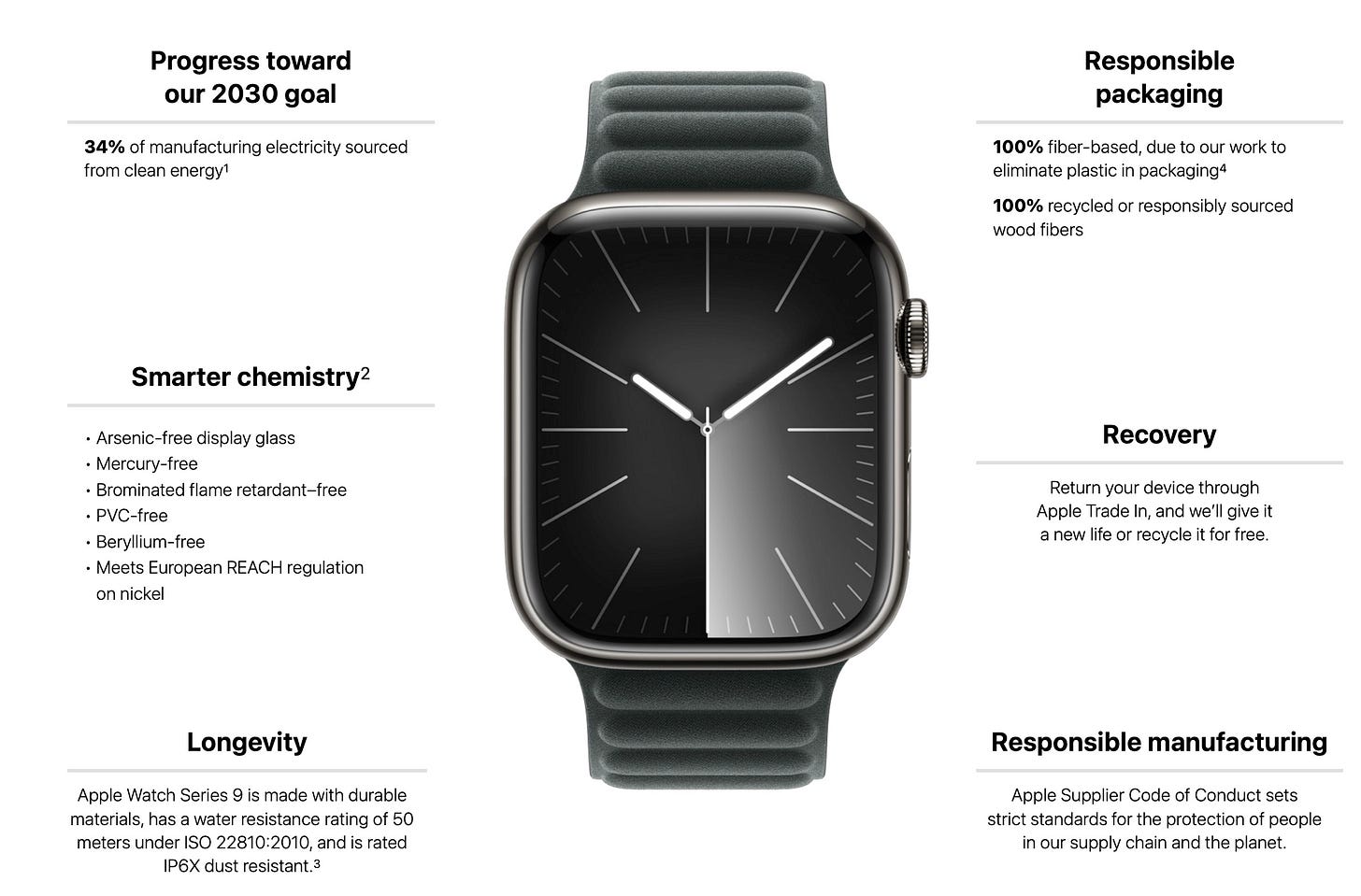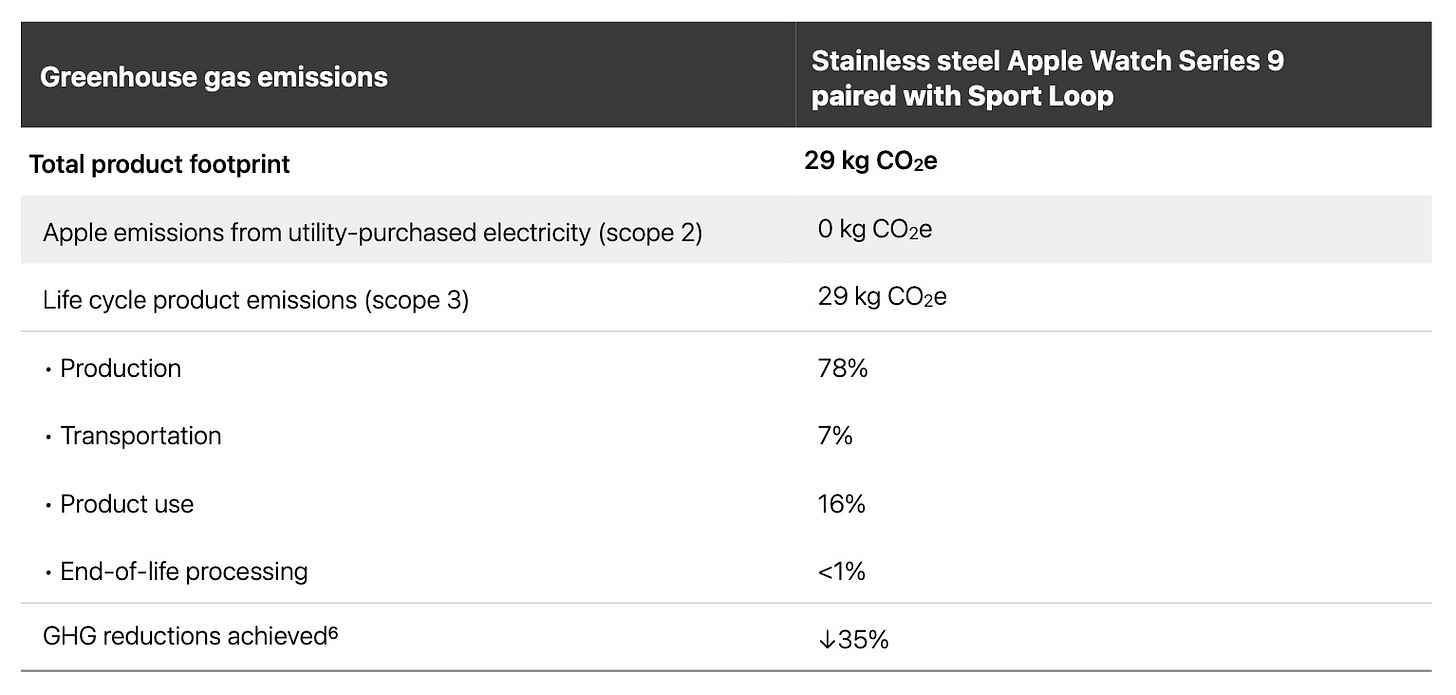Are the new Apple Watches truly "carbon neutral"?
The only truly carbon-neutral watch is the one you don't buy.
I am writing this on my MacBook Air, wearing my Apple Watch 8, while listening on my AirPods; I am a big fan of Apple products. In my book, Living the 1.5-degree Lifestyle, I calculated that “the footprint of my Apple paraphernalia totals 1.271 tonnes, and even spread over three years, this is a fifth of my carbon budget. On a daily basis, it’s 0.891 kg, almost as much as gas and electricity.”
I have also been a fan of Apple’s environmental initiatives and their forthrightness in publishing lifecycle carbon assessments of their products with enough detail that I could calculate my carbon footprint. So, I was intrigued by their recent announcement that the new Apple Watch lineup was “carbon neutral,” with the goal of every product being carbon neutral by 2030. What do they mean by this?
“Apple has adopted a clear and rigorous approach to product decarbonization that prioritizes reducing greenhouse gas emissions from the three biggest sources across the product life cycle: electricity, materials, and transportation. Only after Apple steeply cuts product emissions, will the company apply high-quality carbon credits from nature-based projects for emissions that cannot yet be avoided or reduced with existing solutions.”
Many people are not convinced that there is such a thing as “high-quality carbon credits from nature-based projects” like planting trees. Apple claims they are “from projects that are real, additional, measurable, and quantified, with systems in place to avoid double-counting, and that ensure permanence.”
But Joseph Romm, a physicist and author now with the Penn Center for Science, Sustainability and the Media, recently published a paper titled “Are carbon offsets unscalable, unjust, and unfixable—and a threat to the Paris Climate Agreement?” and claims that “There is a growing consensus that companies should not be using any offsets they buy from developing countries to make claims about emissions reductions or net zero.” and that “Net-zero targets are mostly greenwash” that focus on “offsets instead of reducing emissions.”
Just this morning in the Guardian, they discussed a new report that finds Rainforest carbon credit schemes misleading and ineffective, although it does not discuss the organizations that Apple supports.
Not everyone is negative about offsets and how they are used; Apple is reducing emissions first and then offsetting the balance. I interviewed Nick Aster of South Pole, a company involved in carbon reduction, for a Green Building Advisor article on offsets, and he told me:
“Nobody in this business thinks that offsets of any type are the solution. Their purpose is to offset what can’t be reduced. You take your measurements, you understand where you are, you set your goals, you determine what can be reduced, and then offsets are simply to cover that remainder.”
It is a touchy subject. The phrases “carbon neutral” and “net zero” are slippery and not well defined. I wrote Apple’s press lead and asked for definitions but did not get a response. I am usually dubious about net-zero claims, but I have known Nick since Treehugger was founded (he helped start it), and he describes a sensible strategy: you do the best you can and then offset the rest.
So what is so special about the Apple Watch 9 that makes it carbon neutral, compared to my Apple Watch 8? As far as the physical watch goes, not much has changed. Lifecycle carbon emissions are down from 33 kilograms of carbon emissions to 29; Apple claims a bigger reduction from 45 kg, but that is from their 2015 baseline, not their last watch. Most of the reduction apparently comes from using more low-carbon electricity.
“Electricity for manufacturing and charging devices represents the largest source of Apple’s emissions across all product lines. To address the latter, Apple has committed to invest in large-scale solar and wind projects around the world. For the carbon-neutral Apple Watch models, the company will match 100 percent of customers’ expected electricity use for charging.”
I have bold-faced that last line because it is significant: Apple is taking responsibility for Scope 3 emissions, those which come from the customers’ operation of the watch, which are usually ignored. This is why most claims of carbon neutrality are egregious greenwashing: see my post about how oil companies claim to be going Net Zero by ignoring what comes out of their customers’ tailpipes.
Unlike an oil company’s product, Apple’s Scope 3 emissions are teensy, estimated at 16% of the full life cycle emissions based on the dirty American electric grid. This might be one reason why the watch is their first carbon-neutral product; it’s 85% upfront carbon, and there is not much user electricity to match. Apple has also done great work in using recycled materials, including 100% recycled cobalt. By every standard, the new watches are incrementally better and greener.
But in the end, I am struggling to figure out what makes the new watches significantly different from the previous model, other than the commitment to offset the emissions they cannot eliminate. They have cut a couple of kilos and planted some trees that will take years to suck up the carbon that making the watches pumped out now. Does this change the world?
And it doesn’t do anything to address the carbon elephant in the room: our unnecessary consumption.
Will Arnold of the Institution of Structural Engineers prepared this illustration for the construction world, but it applies to everything: the true key to getting to net zero is to use less stuff.
Apple might reduce its emissions incrementally by 4 tonnes between watch designs, but I could drop them a whole lot more by not buying a new watch in the first place, or by refurbishing my old one. One also has to be clever about needs and wants; I bought my iPhone 11 Pro because I wanted the wide-angle camera. The iPhone 15 has a 48-megapixel camera that looks amazing, but do I need that? Do I need to text by satellite? No, my phone is still a marvellous bit of engineering. It works fine.
The best way to reduce the carbon footprint of an Apple product is not to replace it at all; then, the 29-kilogram carbon footprint goes to almost zero. Unfortunately, that’s not much of a business model for a three trillion-dollar company.
Other companies, like Fairphone or the Framework laptop, make phones and computers that are designed to be easily upgradable and repairable. Apple does not; as Raz Godelnik, assistant professor at Parsons School of Design notes on LinkedIn,
“Apple's business model still revolves around selling customers new versions of its products that are released every year. If anything, this makes it a poster child for an outdated business model grounded in planned obsolescence.”
I have often complained about some of Apple’s green marketing claims, from their recycled aluminum to their “green” Apple headquarters with its ten thousand parking spaces, but have generally been impressed with their environmental ambitions. But Godelnik points out that even this might be an issue:
“The message Apple is sending here to its customers is that this type of overconsumption is still acceptable, even in the era of the climate crisis. Apple wants us to believe that the company and its customers can have the cake and eat it, too. Unfortunately, this is nothing but wishful thinking.”
I am not certain that many people would rush out to buy a new Apple Watch because it is carbon neutral or Net Zero, but Godelnik is right; consumption is still consumption, and the Apple Watch 9 still pumps out 29 kilograms of carbon. We need zero without a net, which is why the only truly carbon-neutral watch is the one you don't buy.
I have written about offsets at Green Building Advisor and wrote here previously about the colours of aluminum.
Raz Godelnik raised the issue of planned obsolescence; I wrote a bit about this in my last book, Living the 1.5-degree Lifestyle. Look for a bonus edition this afternoon with an excerpt from it.
I do believe that Apple is serious about its green credibility, but this video of Mother Nature arguing with Tim Cook is a bit over the top:







Great read, thanks for sharing. You point out an interesting tension for Apple here which I haven’t thought of before - encouraging an annual upgrade cycle whilst also trying to hit ‘net zero’. The two are diametrically opposed. But, I do applaud Apple’s efforts, they’re doing more than most and that should be celebrated, albeit the bar still needs setting much higher.
I watched that Mother Nature commercial and wondered why there was no mention of sourcing raw materials, only packaging. That worries me the most—the child labour and enviro devastation invovled in mining precious metals for these devices, etc.